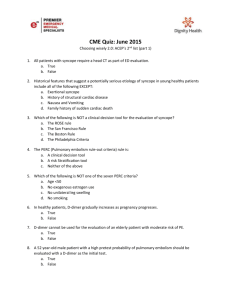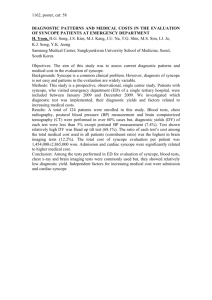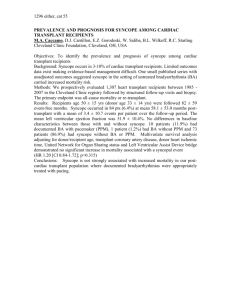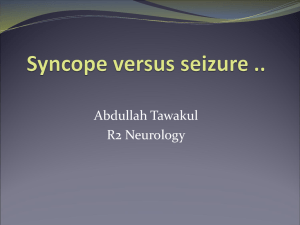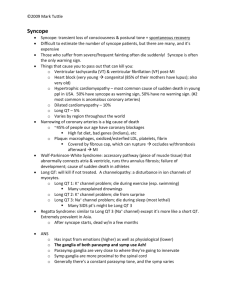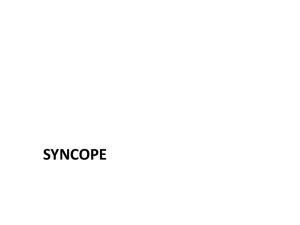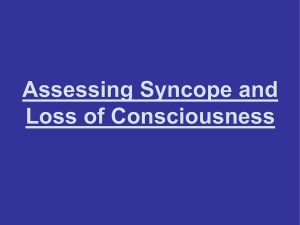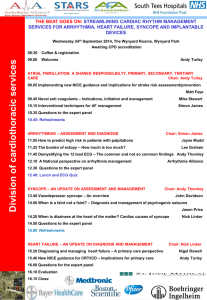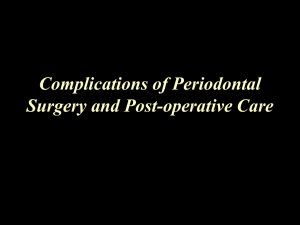Syncope - Lourdes Health System
advertisement
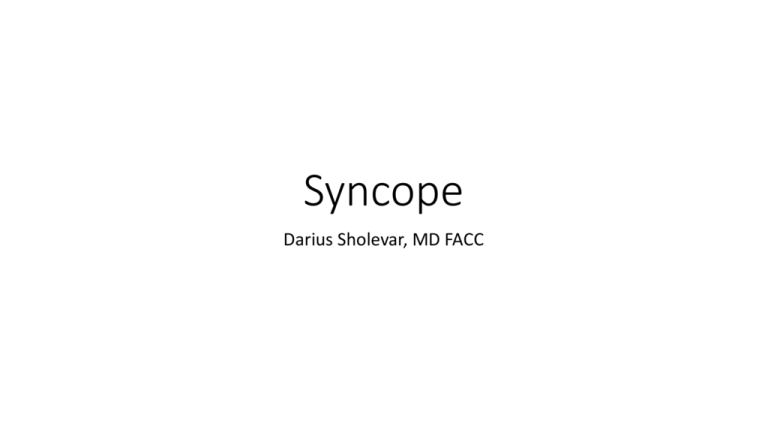
Syncope Darius Sholevar, MD FACC Disclosures – Research Collaboration • Medtronic • St. Jude • Boston Scientific • Angel medical systems • Biosense Webster Definition - Syncope is derived from the Greek words: syn (with) + Koptein (to cut) = to interrupt - It is defined as a transient self limited loss of consciousness due to transient global cerebral hypoperfusion. Impact of Syncope: US Trends – A Common Problem Inpatient Trend* Physician Office Visits** 440,000 1,200,000 420,000 1,100,000 1,000,000 400,000 900,000 380,000 800,000 360,000 700,000 340,000 600,000 320,000 500,000 300,000 400,000 1996 1997 1998 1999 2000 2001 2002 1996 1997 1998 1999 2000 2001 *All patients discharged with syncope and collapse (ICD-9 Code:780.2) listed among diagnoses. **Syncope and collapse (ICD-9 Code: 780.2) listed as primary reason for visit. NHDS 2003. NAMCS 2002. UNKOWN - 40% Vasovagal Syncope – 37% Cardiac Arrhythmias – 15% Syncope Orthostasis Drug / Medication Induced Structural Heart Disease Loss of Consciousness Cerebrovascular Disease Seizure Pseudo-Syncope Psychogenic Syncope Syncope Risk by Cause • Survival with and without syncope • 6-month mortality rate of greater than 10% • Cardiac syncope doubled the risk of death Soteriades ES, et al. NEJM . 2002;347:878-885. N Engl J Med. Sept. 19, 2002 What to Do Next? How To Evaluate Syncope Transient Cause No testing, Treat Cause and Avoid History and Physical Neurocardiogenic Syncope Suspected Suspect Cardiac Etiology or Structural Heart Disease Admission, Rare Episodes Frequent Episodes Lifestyle Modification EKG and Referral Cardiology Evaluation History – Telltale Findings • Seizure – Aura, Tongue bites, prolonged confusion after episode, incontinence, automatisms, hemi-lateral seizure activity, aching muscles • Watch out for Tonic Clinic Activity from Syncope • Neurocardiogenic syncope – noxious stimuli, after exertion, sweating, nausea, very brief tonic clinic movements (less than 30 seconds) • Cardiac Etiology – history of congestive heart failure or myocardial infarction, QT prolonging medications, episodes occurs during exertion, family history of sudden death / SIDS • Palpitations starting as first symptom • Carotid sinus hypersensitivity – tight color or on head or neck turning • Orthostasis – prolonged sitting or standing • Psychogenic – frequent attacks with somatic complaints and negative symptom rhythm correlation When to Hospitalize • Often a clinical decision • • • • • • Arrhythmic, cardiovascular cause New neurological abnormality Multiple, frequent episodes Severe orthostatic hypotension Elderly patient Treatment requiring admission Further evaluation • Carotid sinus massage • ECG monitoring • Echocardiogram • Ambulatory ECG Monitoring • Holter • Event Monitor • Implantable loop recorders • Tilt testing • Electrophysiological testing • Stress Testing – syncope during exercise Diagnostic Methods and Yields Procedure History and Physical Exam Yield* 25-35%1 ECG 2-11%2 Monitoring Holter Monitoring 2%3 External Loop Recorder 20% 3 Insertable Loop Recorder 43-88%4,5,6 Test/Procedure Tilt Table 11-87% 1,7 EP Study without SHD** 11% 8 EP Study with SHD 49% 1 Low Yield Testing for Syncope • Cardiac enzymes • CT scan • Carotid Doppler's • Neurology consult – 0-4% diagnostic yield • EEG • Psychiatric consultation Carotid Sinus Massage • Outcome • Positive if BP drops > 50 mmHg and/or > 3 sec. asystole1 • Absolute contraindications2 • MI, TIA, or stroke in past 3 months; carotid bruits • Relative contraindications • Previous VF, VT 1Kenny 2Linzer RA. Heart. 2000;83:564. M. Ann Intern Med. 1997;126:989. ECG Abnormalities Predicting Cardiac Syncope • Bradycardia less than 50 bpm • LBBB & Bifasicular Block • Second degree AV Block • Third Degree AV block • Long QT interval • Brugada syndrome • Pre-excitation • Myocardial infarction • Ventricular Arrhythmias When to Perform a Heart Monitor • Holter monitor is rarely indicated unless there is very frequent syncope or dizziness • Exception may be high suspicion of frequent arrhythmias • External loop recorders should be considered in patients with a symptom interval of less than 4 weeks • Implantable loop recorders should be considered for most people with syncope who have symptoms less than once a month and more than once every three years Up to 1/3 of Patients with Strokes of Unknown Cause may Have Atrial Fibrillation Pause noted at 0630 – Diagnosis? Crystal AF Sanna et al N Engl J Med 2014; 370:2478-2486June 26, 2014 Echocardiogram -Screening tool to rule out cardiac disease -Low yield -Mitral valve prolapse is the most frequent coincidental finding Tilt table testing • Pathophysiology • The autonomic reflex: -arterial and cardiopulmonary mechanoreceptors –brain stem –vagus & the sympathetic efferent neurons • Protocols • Isoproterenol vs. NTG (94% specificity) When to Perform an EP Study • Patients with ischemic heart disease • Patients with myocardial scar • Bifasicular block • Palpitations preceding syncope • Other situations where value is unclear – Brugada syndrome, hypertrophic cardiomyopathy, undiagnosed syncope Patient with Syncope and Bifasicular block on EKG Patient with Syncope Associated with Palpitations A1H1 A1H1 A1H1 A1H1 AH Jump Treatment Options Bradycardia Pacemaker Ventricular Arrhythmia ICD Neurocardiogenic Syncope Lifestyle modification Midodrine Fludrocortisone Medications Beta Blockers Pyridostigmine Pacemaker Support Stockings The End www.bostonscientific.com/cardiac-rhythm-resources/cameron-health/sicd-system.html Questions • 1 – What is the highest yield diagnostic maneuver for syncope? • 2 – What are two the most important test for ruling out a life threatening cause of cardiogenic syncope? • 3 – What is the most important factor when choosing a heart monitor? Questions - Answers • 1 – What is the highest yield diagnostic maneuver for syncope? • History and Physical Exam • 2 – What are two the most important test for ruling out a life threatening cause of cardiogenic syncope? • EKG and Echocardiogram • 3 – What is the most important factor when choosing a heart monitor? • Frequency of Symptoms European Heart Journal (2009) 30, 2631–2671; doi:10.1093/eurheartj/ehp298 Treatment • Neurocardiogenic/ vasovagal syncope • Carotid sinus syndrome • Situational syncope • Orthostatic hypotension Tilt Training • Treatment of malignant and recurrent vasovagal syncope • 42 tilt-positive patients performed home tilt training: two, 30-minute sessions daily • After follow-up of 15.1±7.8 mos: • 36 syncope free; 4 “presyncope”; 1 recurrence • Conclusion: The abnormal autonomic reflex activity of vasovagal syncope can be remedied Reybrouck T, et al. PACE. 2000;23:493-498. Prevention Of Syncope Trial (POST) • Hypothesis: metoprolol will increase the time to the first syncope recurrence • Double-blind, randomized, placebo-control trial, powered to detect 50% relative risk reduction of recurrent syncope • Inclusion: >3 vasovagal spells, +TTT, age >18 • 208 patients; 38% completed follow-up without syncope • Metoprolol ineffective overall. Age <42 did worse and age >42 improved* • Conclusion - metoprolol first line drug therapy for age >42 *p=0.026 interaction with age Sheldon R. HRS, San Fran. 2004. Midodrine - Vasovagal Syncope 100 Symptom – Free Interval 80 60 Midodrine Fluid 40 20 p < 0.001 0 0 20 40 60 80 100 Months Perez-Lugones A, et al. JCE. 2001;12:935-938. 120 140 160 180 Pacemakers for Syncope VPS I (North American Vasovagal Pacemaker Study) • Objective: to evaluate pacemaker (PM) therapy for severe recurrent vasovagal syncope • Randomized, prospective, single center • N=54 Patients • 27—DDD pacemaker with rate drop response • 27—no pacemaker • Inclusion: vasodepressor response • Primary outcome: first recurrence of syncope Connolly SJ. J Am Coll Cardiol. 1999;33:16-20. VPS I (North American Vasovagal Pacemaker Study) 100 90 Cumulative Risk (%) 80 No Pacemaker (PM) 70 60 2P=0.000022 50 40 30 Pacemaker 20 10 Inclusion: vasodepressor response 0 0 3 6 9 Time in Months 12 15 Results: 6 (22%) with PM had recurrence vs. 19 (70%) without PM 84% RRR (2p=0.000022) Connolly SJ. J Am Coll Cardiol. 1999;33:16-20. VAsovagal Syncope International Study (VASIS) Pacemaker 100 % syncope-free 80 p=0.0004 60 40 No Pacemaker 20 Inclusion: cardioinhibitory response 0 2 3 4 5 6 Years Results: 1 (5%) with PM had recurrence vs. 14 (61%) without PM. Sutton R. Circulation. 2000;102:294-299. VPS II (Vasovagal Pacemaker Study II) • Objective: to determine if pacing therapy reduces the risk of syncope in patients with vasovagal syncope • Randomized, double-blind, prospective, multi-center • N=100 patients: • 52—only sensing without pacing • 48—DDD pacemaker with rate drop response • Inclusion: positive TTT with (HRXBP) < 6000/min X mm Hg • Primary outcome: first recurrence of syncope Connolly S. JAMA. 2003;289:2224-2229. VPS II (Vasovagal Pacemaker Study II) Role of Pacing 1.0 Cumulative Risk 0.8 0.6 Only Sensing Without Pacing (ODO) 0.4 Dual Chamber Pacing (DDD) 0.2 0 0 1 2 3 4 5 6 Months Since Randomization Results: 33% with pacing had recurrence vs. 42% with only sensing (p=NS) Connolly S. JAMA. 2003;289:2224–2229.
